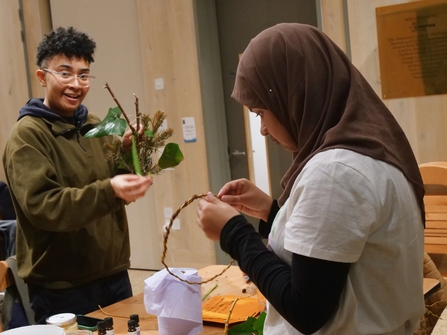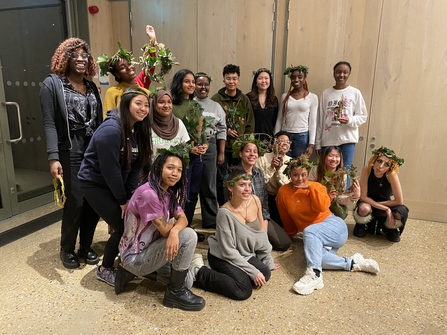Facilitated by Sumayyah Zannath, the Project Research Officer at London Wildlife Trust, collaboratively with partners on the project Wanderers of Colour with support from Natural England, we were able to create safe spaces centring listening, community and co-creation for the sessions that allowed the groups to enjoy exploring nature with peers, build genuine connections and be heard. These perspectives are those that are often excluded from the conversation within the conservation sector, with the eye-opening experiences of young people of colour followed by actionable recommendations, we are hopeful this report can support the action needed to ensure nature really is for everyone.
Seeding Change Report: shining a light on the barriers to nature conservation volunteering for young women and non-binary people of colour
Background
Based on feedback from participants and survey respondents, the report explores barriers to inclusion across three main themes – safety, relevancy, and accessibility – and offers recommendations for organisations aiming to increase engagement with young women and non-binary people of colour.
The aim was to enable young women and non-binary people of colour to discover, explore and enjoy the wild spaces on their doorstep.
Girls and young women were supported to:
- Overcome negative perceptions of who wild spaces are for
- Gain confidence in using the outdoors and improve self-esteem
- Foster a deeper sense of place and belonging
- By physically active in and for their local natural environment
- Become ready for pathway opportunities into the conservation sector
- Develop a love of nature that will support strong mental health for a lifetime
What does nature conservation mean to you?
This was a question asked to everyone who engaged with the Seeding Change project, whether through the survey or during discussions held at in-person sessions. ‘Protecting’ was the most common term used to describe conservation, with ‘preserving’ and ‘defending’ also frequently appearing in people’s responses. 25% of survey respondents did not know what nature conservation meant with many more respondents offering guesses whilst saying that they were unsure if their guesses were correct. Other people shared that despite being interested in volunteering in green spaces and with wildlife, they could not imagine being part of the nature conservation sector itself.
Each and every community has its own needs and as recognised by this participant, practical nature conservation sessions that are not tailored to meeting these specific needs often become spaces solely for those from over-represented communities who already feel comfortable in them.
Read the full report below:
Imposter syndrome…The land doesn’t technically belong to us…my mother came to this country and when someone asks me where I’m from, I say I’m from Somalia. I don’t really say I’m British or English because I don’t feel welcome here so it’s hard to feel welcome taking care of the land as well.Seeding Change
Key Recommendations
Safety
Safety is a significant concern for young women and non-binary people of colour, particularly as they are often visibly located at the intersection of multiple racialised and gender-based systems of violence. From our survey respondents, 77% of the total respondents stated that previous experiences of feeling unsafe whilst in a green space has now made them less likely to engage in opportunities and nature conservation volunteering in the future.
Recommendations:
- Designated spaces and programmes for underrepresented communities
- Privacy whilst engaging in practical nature conservation activities
- Clean and accessible facilities
Relevancy
Young women and non-binary people of colour engage with nature for a variety of reasons that reflect their own existing interests, and recognising and incorporating this into the planning and delivery of sessions is essential to long-term engagement with nature conservation.
Recommendations:
- Varied content of activities, with opportunities for co-design
- Community connections and partnerships
- Representative staff and workshop leads
- Diversified media engagement
- Transparency regarding site activities (detailed pre-event information)
Accessibility
Existing accessibility concerns are exacerbated when working with communities that are underrepresented within the environmental and conservation sector as there is often a lack of existing knowledge of or perceived interest in ‘nature conservation’ work, despite communities perhaps being otherwise engaged in green spaces in various ways.
Recommendations:
- Accessible language and no jargon
- Reimbursement of volunteer expenses and refreshment/lunch provision
- Varied times/days for activities (combination of weekdays, evenings, weekends)
Opening the conversation on conservation
Themes of colonialism, extraction and elitism emerged from these discussions and it is clear that there is a significant amount of trust-building that must be done to ensure that people of colour– and particularly those also experiencing gender marginalisation – feel safe and welcome within the nature conservation sector. Communities of colour continue to incorporate their inherited skills and knowledge into their relationships with the green spaces that are local to them in London, but there continues to be distrust towards the nature conservation sector and what it symbolises for their communities.
I feel broken in my relationship with nature. I know that so much was taken from my people, indigenous people are nature's care takers and colleagues, my Jamaican family farm their own land but I can't even keep a cactus alive. I feel the loss of knowledge and connection, there's a gaping hole that's been lost to colonialism and I don't know how to fix it.Seeding Change
Due to the historic and ongoing criminalisation of young people – and particularly young people of colour – many now feel unsafe and unwelcome in public spaces, particularly within parks and nature reserves. It was made clear that by having a regular time or space/ programme that is designated specifically for youth engagement would facilitate their ability to create positive and long-term relationships with both wildlife and green spaces.
I was happy to see that the session prioritised women and non-binary people of colour so it felt like somewhere I could come as myself and experience nature in a safe space.Seeding Change
These are larger and more meaningful conversations and concerns that already exist within marginalised communities and creating spaces and platforms for them to be spoken about openly will demonstrate that large organisations are willing to listen and respond to the needs of marginalised communities.
Community Connections
The importance of building relationships between organisations such as London Wildlife Trust and existing local green spaces, grassroots nature conservation organisations and youth organisations cannot be understated. Co-designing safe spaces, facilitating valuable activities, and engaging with audiences of young people of colour were carried out in partnership with Wanderers of Colour, a people of colour-led grassroots collective based in the UK with members across the globe.
I came because I joined one of the Wanderers of Colour events in the past and it really shows the cluster effect…it’s really about creating spaces that bring people together and that’s how you create traction.Seeding Change
The collective runs a range of activities with the aim of increasing access and participation within the outdoors and travelling, and an increased understanding of the systematic issues within these. Wanderers of Colour supported delivery of the project through helping build the project framework, mapping outcomes, co-designing and delivering workshops and disseminating the survey, as well as feeding into the overall research report. It is necessary for organisations to commit to meaningfully being present within local communities and building relationships of trust and partnership with relevant organisations.
It was great being able to partner with the London Wildlife Trust, on such an important project. The intersection of being a person of colour and a woman or non-binary within the conservation sector, and the barriers we experience in these spaces is a necessary area to explore, in the work of protecting and engaging with nature. It was crucial to have people of colour leading on this project, and design activities that centred our needs and platform voices that are often missing in conservation and nature discourse.Founder of Wanders of Colour

The findings in the report are really eye opening and show how many barriers young women and non-binary people of colour face when it comes to connecting with nature, and all the benefits that brings. It’s good to see some excellent recommendations on how to move this forward, and we hope this report can be used across the country to help address many of the barriers it raises, so that we can help nature recover together.Thames Solent Area Manager from Natural England

London Wildlife Trust delivered this research project as a continuation point to address the barriers to inclusion on our reserves and within the wider sector, Leah McNally, Director of Learning, Youth & Communities at London Wildlife Trust said:
We are really pleased to publish our 'Seeding Change' research which has brought together consultation findings to provide a series of important recommendations. We hope that our report will support our sector to think more deeply about the background to barriers that young women and non-binary people of colour face when accessing green spaces and getting involved in taking action for nature through nature conservation volunteering.London Wildlife Trust
As the findings from the Seeding Change research project have demonstrated, there is still work to be done to extend this outreach to include underrepresented communities within the nature conservation sector, including women and non-binary people of colour. We will be implementing this research through our programmes, linked to our 2030 strategy 'Bringing Nature back to London’, the findings of this report will be used to inform London Wildlife Trust’s volunteering programme going forwards, as well as being shared more widely with organisations across the nature conservation sector.
